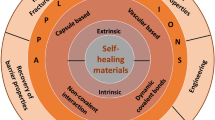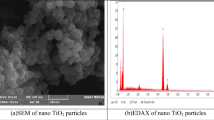Abstract
The aim of this study was to investigate the in vivo degradation mechanism and the mechanical properties of poly(lactide-co-glycolide)/beta-tricalcium phosphate (PLGA/β-TCP) composite anchors. Anchors composed of PLGA and β-TCP were implanted in the dorsal subcutaneous tissue of beagle dogs for 6, 12, 16, and 26 weeks. The degradation of the materials was evaluated by measuring the changes in thermal behavior, crystallinity, and mechanical properties. Scanning electron microscope (SEM) was used to observe the surface and longitudinal section of the material. The evaluation of mechanical strength retention and degradation properties suggest that the addition of β-TCP particles efficiently enhances their mechanical properties and thermal characteristics and delays their degradation rate. By analyzing the results of SEM, X-ray diffraction, and differential scanning calorimetry, we can infer that after 12 weeks, the connection between β-TCP and PLGA becomes less compact, which accelerates the decline of mechanical strength.







Similar content being viewed by others
References
E.S. Dejong, T.M. DeBerardino, D.E. Brooks, and K. Judson: In vivo comparison of a metal versus a biodegradable suture anchor. Arthroscopy 20, 511 (2004).
F.A. Barber and S.A. Hrnack: Poly L-lactide co-glycolide/beta-tricalcium phosphate interference screw fixation for bone-patellar tendon bone anterior cruciate ligament reconstruction. J. Knee Surg. 26, 423 (2013).
N.J. Gunja and K.A. Athanasiou: Biodegradable materials in arthroscopy. Sports Med. Arthrosc. Rev. 14, 112 (2006).
K. Moncal, D. Heo, K. Godzik, D. Sosnoski, O. Mrowczynski, E. Rizk, V. Ozbolat, S. Tucker, E. Gerhard, M. Dey, G. Lewis, J. Yang, and I. Ozbolat: 3D printing of poly(ε-caprolactone)/poly(D,L-lactide-co-glycolide)/hydroxyapatite composite constructs for bone tissue engineering. J. Mater. Res. 14, 1972 (2018).
L.M. Ehrenfried, M.H. Patel, and R.E. Cameron: The effect of tri-calcium phosphate (TCP) addition on the degradation of polylactide-co-glycolide (PLGA). J. Mater. Sci. Mater. Med. 19, 459 (2008).
O. Bostman, E. Hirvensalo, J. Makinen, and P. Rokkanen: Foreign-body reactions to fracture fixation implants of biodegradable synthetic polymers. J. Bone Joint Surg. 72, 592 (1990).
P.U. Rokkanen, O. Bostman, E. Hirvensalo, E.A. Makela, E.K. Partio, H. Patiala, S.I. Vainionpaa, K. Vihtonen, and P. Tormala: Bioabsorbable fixation in orthopaedic surgery and traumatology. Biomaterials 21, 2607 (2000).
A. Weiler, H.J. Helling, U. Kirch, T.K. Zirbes, and K.E. Rehm: Foreign-body reaction and the course of osteolysis after polyglycolide implants for fracture fixation: Experimental study in sheep. J. Bone Joint Surg. 78, 369 (1996).
D.S. Mastrokalos and H.H. Paessler: Allergic reaction to biodegradable interference poly-L-lactic acid screws after anterior cruciate ligament reconstruction with bone-patellar tendon-bone graft. Arthroscopy 24, 732 (2008).
J.H. Kwak, J.A. Sim, S.H. Kim, K.C. Lee, and B.K. Lee: Delayed intra-articular inflammatory reaction due to poly-L-lactide bioabsorbable interference screw used in anterior cruciate ligament reconstruction. Arthroscopy 24, 243 (2008).
M.S. Taylor, A.U. Daniels, K.P. Andriano, and J. Heller: Six bioabsorbable polymers: In vitro acute toxicity of accumulated degradation products. J. Appl. Biomater. 5, 151 (1994).
K. Tecklenburg, P. Burkart, C. Hoser, M. Rieger, and C. Fink: Prospective evaluation of patellar tendon graft fixation in anterior cruciate ligament reconstruction comparing composite bioabsorbable and allograft interference screws. Arthroscopy 22, 993 (2006).
P.Q. Ruhe, E.L. Hedberg, N.T. Padron, P.H. Spauwen, J.A. Jansen, and A.G. Mikos: Biocompatibility and degradation of poly(D,L-lactic-co-glycolic acid)/calcium phosphate cement composites. J. Biomed. Mater. Res., Part A 74, 533 (2005).
V. Martinek, R. Seil, C. Lattermann, S.C. Watkins, and F.H. Fu: The fate of the poly-L-lactic acid interference screw after anterior cruciate ligament reconstruction. Arthroscopy 17, 73 (2001).
F.A. Barber, D.B. Spenciner, S. Bhattacharyya, and L.E. Miller: Biocomposite implants composed of poly(lactide-co-glycolide)/beta-tricalcium phosphate: Systematic review of imaging, complication, and performance outcomes. Arthroscopy 33, 683 (2017).
F.D. Bach, R.Y. Carlier, J.B. Elis, D.M. Mompoint, A. Feydy, O. Judet, P. Beaufils, and C. Vallee: Anterior cruciate ligament reconstruction with bioabsorbable polyglycolic acid interference screws: MR imaging follow-up. Radiology 225, 541 (2002).
J.B. Ticker, R.J. Lippe, D.E. Barkin, and M.P. Carroll: Infected suture anchors in the shoulder. Arthroscopy 12, 613 (1996).
K.H. Frosch, T. Sawallich, G. Schutze, A. Losch, T. Walde, P. Balcarek, F. Konietschke, and K.M. Sturmer: Magnetic resonance imaging analysis of the bioabsorbable Milagro interference screw for graft fixation in anterior cruciate ligament reconstruction. Strategies Trauma Limb Reconstr. 4, 73 (2009).
L. Lin, T. Wang, Q. Zhou, and N. Qian: The effects of different amounts of drug microspheres on the vivo and vitro performance of the PLGA/beta-TCP scaffold. Des. Monomers Polym. 20, 351 (2017).
M.A. Tracy, K.L. Ward, L. Firouzabadian, Y. Wang, N. Dong, R. Qian, and Y. Zhang: Factors affecting the degradation rate of poly(lactide-co-glycolide) microspheres in vivo and in vitro. Biomaterials 20, 1057 (1999).
T. Nieminen, I. Rantala, I. Hiidenheimo, J. Keranen, H. Kainulainen, E. Wuolijoki, and I. Kallela: Degradative and mechanical properties of a novel resorbable plating system during a 3-year follow-up in vivo and in vitro. J. Mater. Sci. Mater. Med. 19, 1155 (2008).
S.S. Jensen, M.M. Bornstein, M. Dard, D.D. Bosshardt, and D. Buser: Comparative study of biphasic calcium phosphates with different HA/TCP ratios in mandibular bone defects. A long-term histomorphometric study in minipigs. J. Biomed. Mater. Res., Part B 90, 171 (2009).
S.S. Jensen, A. Yeo, M. Dard, E. Hunziker, R. Schenk, and D. Buser: Evaluation of a novel biphasic calcium phosphate in standardized bone defects: A histologic and histomorphometric study in the mandibles of minipigs. Clin. Oral Implants Res. 18, 752 (2007).
S.K. Nandi, G. Fielding, D. Banerjee, A. Bandyopadhyay, and S. Bose: 3D-printed β-TCP bone tissue engineering scaffolds: Effects of chemistry on in vivo biological properties in a rabbit tibia model. J. Mater. Res. 14, 1939 (2018).
M. Obadal, R. Čermák, M. Raab, V. Verney, S. Commereuc, and F. Fraïsse: Structure evolution of α- and β-polypropylenes upon UV irradiation: A multiscale comparison. Polym. Degrad. Stab. 88, 532 (2005).
M. Therin, P. Christel, S. Li, H. Garreau, and M. Vert: In vivo degradation of massive poly(alpha-hydroxy acids): Validation of in vitro findings. Biomaterials 13, 594 (1992).
F.H. Lin, T.M. Chen, C.P. Lin, and C.J. Lee: The merit of sintered PDLLA/TCP composites in management of bone fracture internal fixation. Artif. Organs 23, 186 (1999).
C.A. van Blitterswijk, S.C. Hesseling, J.J. Grote, H.K. Koerten, and K. de Groot: The biocompatibility of hydroxyapatite ceramic: A study of retrieved human middle ear implants. J. Biomed. Mater. Res. 24, 433 (1990).
R. Velu and S. Singamneni: Selective laser sintering of polymer biocomposites based on polymethyl methacrylate. J. Mater. Res. 29, 1883 (2014).
R. Velu, B. Kamarajan, M. Ananthasubramanian, T. Ngo, and S. Singamneni: Post-process composition and biological responses of laser sintered PMMA and β-TCP composites. J. Mater. Res. 14, 1987 (2018).
ACKNOWLEDGMENTS
This work was supported by the National High-tech Research and Development Program (863 Program), No. 2015AA033701. Samples were gifts given by Beijing Naton Technology Group Co., Ltd., Beijing.
Author information
Authors and Affiliations
Corresponding authors
Rights and permissions
About this article
Cite this article
Luo, YR., Zhang, L., Chen, C. et al. The delayed degradation mechanism and mechanical properties of β-TCP filler in poly(lactide-co-glycolide)/beta-tricalcium phosphate composite suture anchors during short-time degradation in vivo. Journal of Materials Research 33, 4278–4286 (2018). https://doi.org/10.1557/jmr.2018.407
Received:
Accepted:
Published:
Issue Date:
DOI: https://doi.org/10.1557/jmr.2018.407




